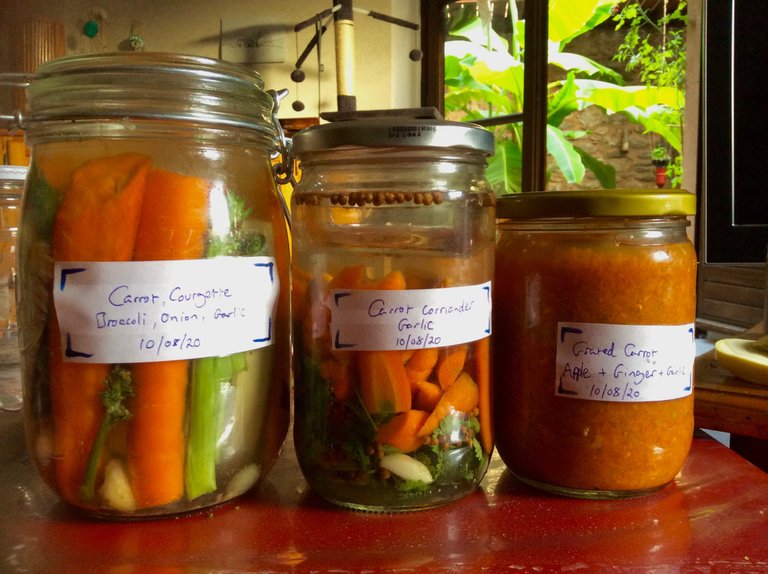
My family are on the other side of France at the moment taking a week with Sabrina's dad, so I have been trying out preservation techniques for all these vegetables we are producing. Yesterday I created the above three jars and would like now to take full advantage of all this extra time I have by sharing my process with you here. Thank you @opidia for the helpful tips a few days ago.
Lacto Fermentation (Lactic acid fermentation)
Lactic acid fermentation is a metabolic process by which glucose and other six-carbon sugars are converted into cellular energy and the metabolite lactate, which is lactic acid in solution. It is an anaerobic fermentation reaction that occurs in some bacteria and animal cells, such as muscle cells. wiki
This technique has come up time and time again during my research as the best way to preserve nutrients, flavours & even that wonderful crunch of a raw carrot. Given time to ferment it becomes a natural probiotic which is extremely good for us and better still, it keeps all winter in the unopened jar.
Listening to YouTubers talk about this it seems to me that humans used to store vegetables this way all the time, until shops appeared on every corner and convenience became the order of the day. Something very important has been lost here and I cannot deny that I am a victim of this loss with no experience whatsoever when it comes to this subject. I've never even tried eating fermented food! But inside I am smiling because this is going to be the healthiest winter I have ever experienced ;)
So, without further ado, let's get started.
Grab your veg
I have been desperately wanting to harvest some of our courtyard carrots which were grown in breathable tubs seen here. They only get around 4-5h of direct sunlight in our courtyard, but apparently this is enough. They aren't too big yet but the flavour is SO much more intense than a store bought carrot.
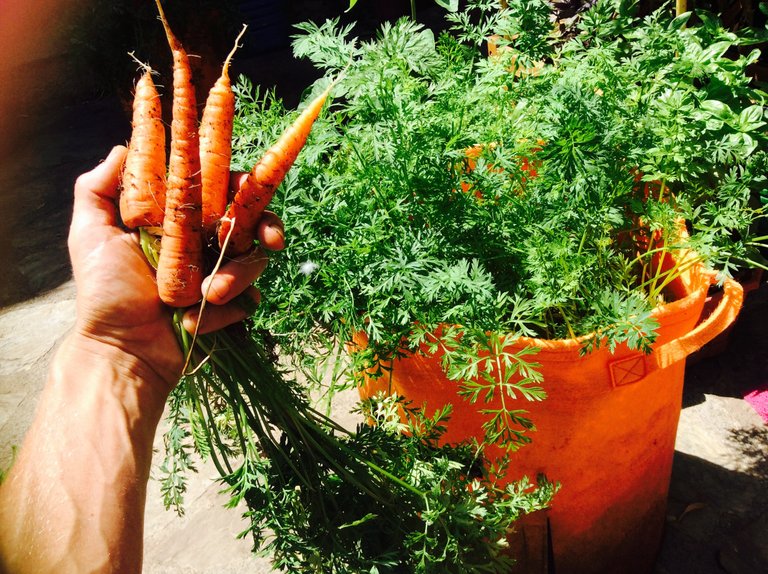
No need to peel homegrown carrots. Just clean the dirt off and you are good to go.
The Ingredients
Here you can see everything I used for my first jar. Baby carrots, coriander leaves, coriander seeds & garlic. All from the garden of course.
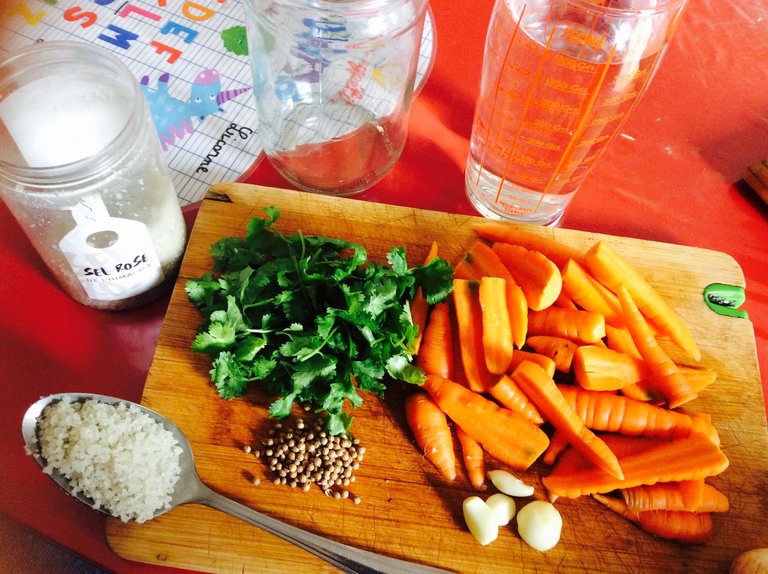
I am using one pint of (unchlorinated) water with one tablespoon of natural salt. This is the key ingredient in any lacto fermentation process.
Mix it all up
The herbs & garlic are placed at the bottom with the carrots on top. The salt is fully dissolved in the water before submerging the veg.

The third item in the above shot is a used desert jar which has been sitting in a box for a long time waiting for this moment! It is important that the vegetables stay under the water, not floating around on the top, so weights are used if the veg isn't tightly packed. The technical name for this device is a pebble weight and you can buy all kinds of fancy glass weights on amazon, but I am left wondering if the old folk didn't just use actual pebbles?
Some people use half a lime as their weight and remove it when the fermenting process is done. I like the sound of this but be sure to wash the skin of the lime thoroughly as they are usually treated with chemicals.
These recycled desert jars work well but do seem to take up quite a lot of space. I will look out for suitable pebbles over these next few days and start collecting!
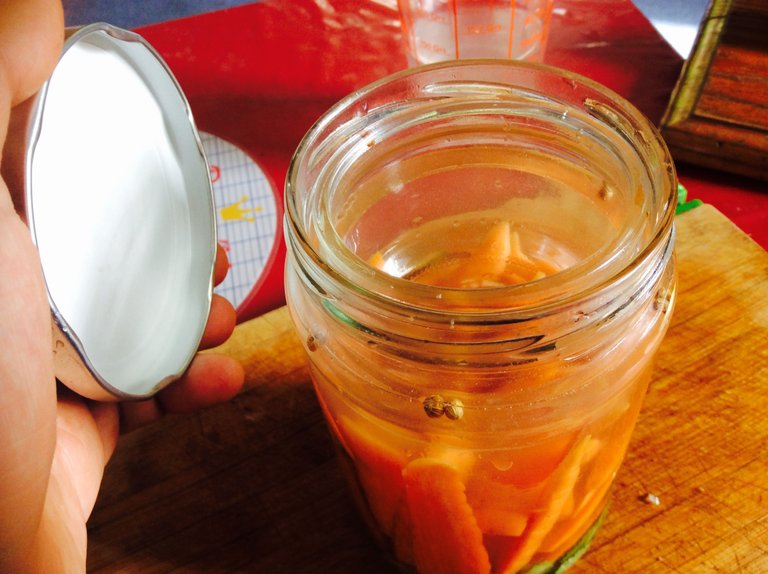
Once you are sure all the air bubbles have been released (by nudging everything around using the handle of a wooden spoon) and that all the veg is all fully submerged, the lid is placed loosely on the top. It is important not to tighten it all the way as gasses are released during the fermentation process.
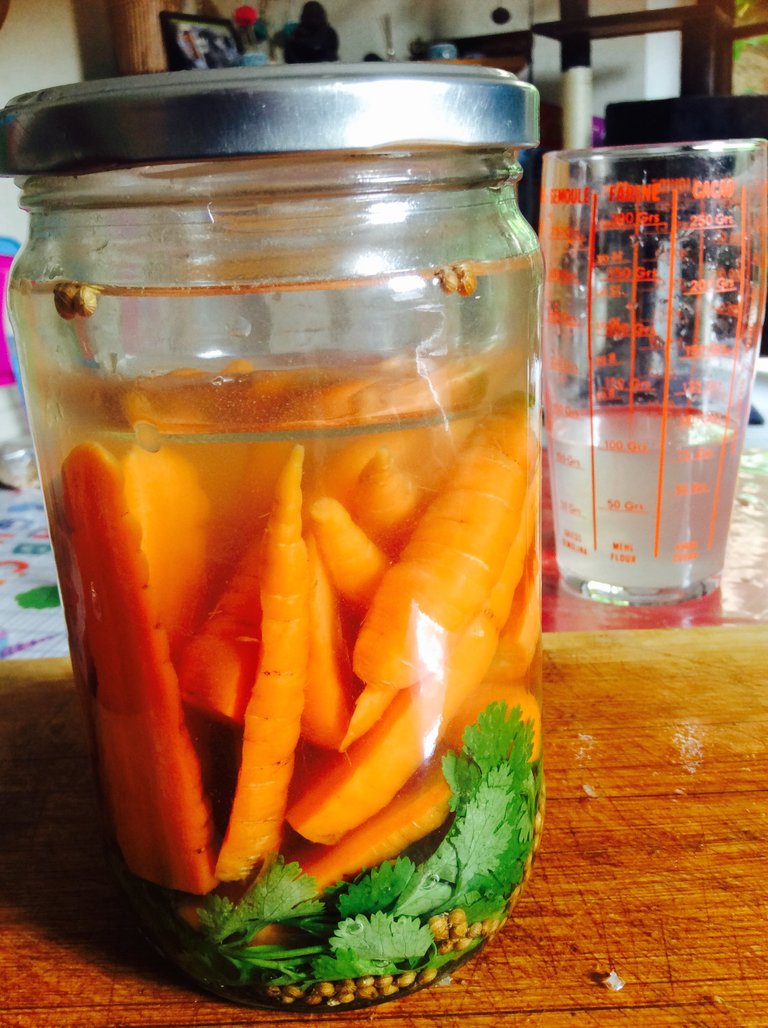
The Fermentation Process
Sitting the tubs off to one side in the kitchen (room temperature) a minimum of three days must now be taken for the process to begin. I understand it is a good idea to check it after three days. If it doesn't smell great something has gone wrong and you must return to step one.
Some people recommend continuing the fermenting process (with the lids on loose at room temperature) for up to a month, occasionally giving it a taste test. In the end it seems to me this bit is down to personal preference.
Once you are satisfied with the flavour, the lids are tightened and jars stored in a cool, dark place. The warmer temperature of a summer time kitchen encourages fermentation, so to slow down the process you will need to find a place which maintains a cooler temperature of around 65-70°F/18-21°C
I understand that putting it in the fridge stops the fermenting process completely, but this is not really necessary. Extra fermenting = extra good for you ;)
What vegetables can you use?
I've not seen anyone using veg which can't be eaten raw (squash, potatoes etc). But generally these kind of vegetables will store all winter anyway, without the need for fermentation.
For my second jar of the day I used a white courgette, little stubs of broccoli (which are quite common when you grown your own), red onion, garlic and the biggest carrots I could find.
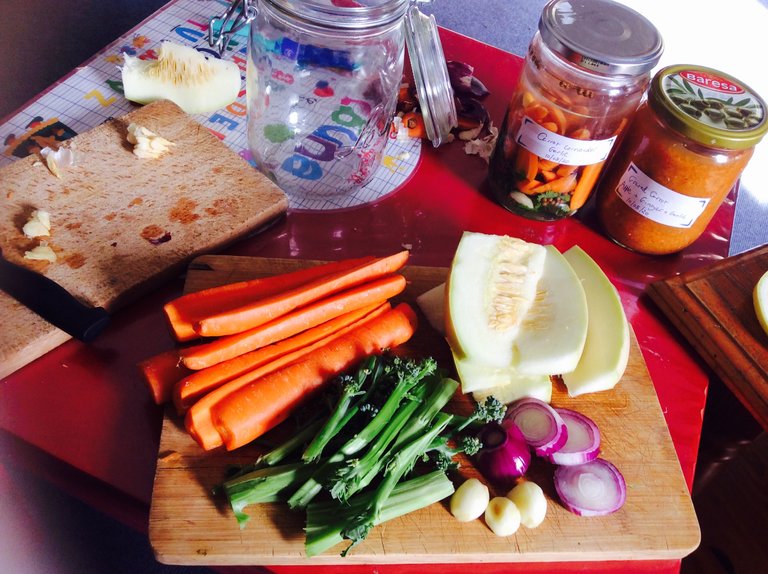
I didn't use a pebble weight for this one as I was able to stuff it all in tight. And the lid mechanism of this jar is different from the others so I removed the rubber sealant ring, ensuring it is not airtight for the fermentation process.
Grated carrots
For the third jar I wanted to grate everything. I liked the sound of the apple, ginger & carrot mix.
The main difference with this one was no added water. Carrots are quite juicy when they are grated so the salt can be added directly. Spend a few mins mixing it all up with your fingers and you will see how much water collects in the mixing bowl without the need for adding anything except salt.
And there you have it.
In the end everyone has a slightly different technique and on YouTube this very often involves the use of a fancy gadget but the basics are clear now and the oldest & simplest ways seem to work fine, so no fancy gadgets are required if you are just starting out.
I am interested to hear if anyone has combination ideas?
Now that I am done ravaging the carrots I have a ton of courgettes which I can only eat so much of. These things just keep getting bigger and bigger!
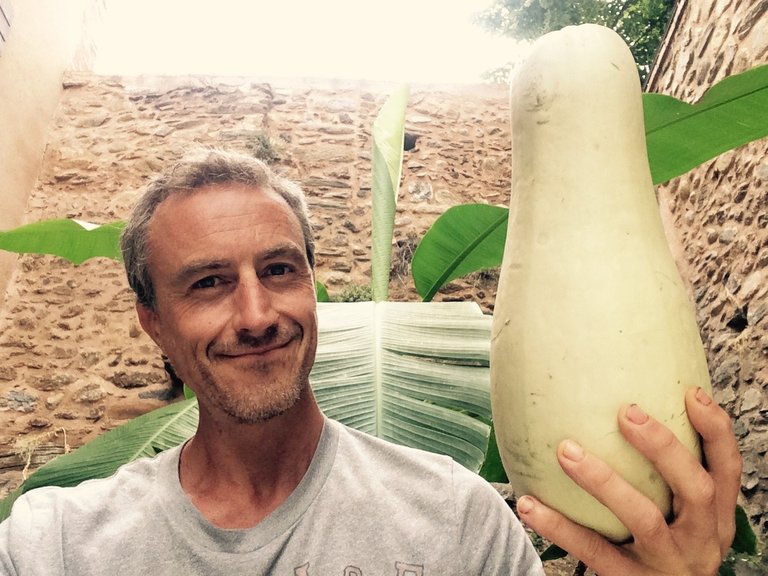
Love & Light everyone 🌱
Thanks!
I see Luna in that picture of you 🌼
Amazing post Sam , keep some of those jars for me 🍯🐝
Took it this morning when the sun was just rising. It is interesting that I stop shaving when the family go away ;)
Speaking to Doris it seems I could have used less salt. I will try some more (with less) and see what happens...x
Yeah funny , but it is not like you are a HAIRY man ahahahha .
As long as it is sea salt its fine , but yes no need to add much salt , but it helps greatly conservation .
I’ve featured your post in The Lotus Garden newsletter, which will be published tomorrow and you've been selected as the recipient of the 5% beneficiary.
Curated for #naturalmedicine (by @minismallholding) - join our community here.
The Lotus Garden is a newsletter supporting content relevant to Homesteaders & supported by Natural Medicine. Earn LOTUS & HIVE for your #homesteading content!
About II Discord II Community
Many thanks for that @minismallholding ;)
This does seem to be an important lesson to spread around as much as possible at this time of year!
Did you know the carrot was produced in The Netherlands during the 17th century?
I didn't! How does one 'produce' such a thing? It must surely have been something similar before someone started cross breeding it? Now you've got me thinking about it, how can any vegetable just appear? All of them must surely have been here always? Hmmm... it's too early in the morning for this train of thought!
Nice tutorial! Cabbage for sauerkraut and kimchi are also common fermented vegs.
Am looking forward to our cabbage being ready for this...
Not long now ;)
Thank you for a great post. We've used this method for cucumbers, and I was wondering about trying it with other vegetables. You've answered all my questions, thank you again!
Thank you for the tip! I am pleased this answered a question for you.
We have a bunch of little cucumbers I would like to try with some dill ;)
What do you mix yours with?
Happy to give the tip, my vote doesn't convey nearly as much compensation as this post deserved.
Our most basic flavors to add are dill and cardamom. We will also frequently add black pepper, mustard seed, and throw a hot pepper in the jar.
@samstonehill, It's always great to know the Nature's and Natural Knowledge because in a way it gives the sense of Ancient Fulfillment. Stay blessed.
What an interesting point. And it's funny you should mention it because I have been feeling something along these lines this entire year, which for the first time in my life has been dedicated exclusively to growing, foraging & storing for the winter. I felt it so strongly a few days ago I almost wrote a post about it. But then I got busy fermenting and stopped thinking about it ;)
But the bottom line is that I am back in tune with my Ancient Ancestors. And they are smiling!
In my opinion it's reflecting as most of the human beings are resonating with the Earth Spirit.
Have a abundant time ahead and stay blessed always.
thanks for sharing, was looking for a way to store more food to avoid going out.
Plus it is Alive
This is the time of year to think about such things. Pleasure to share ;)
I am here because @paradoxtma visited my fermentation post and mentioned that she saw another great similar post. 😀
I made sauerkraut. I have done jalapeños but I will do carrots next time.
Great that you grown your own vegetables.
Hey there! I'm going to check out your kraut making now...
Our cabbages are almost done!
@belemo
And we were just talking about this. I could use one of my bowls to try it.
Posted using Dapplr
Yes